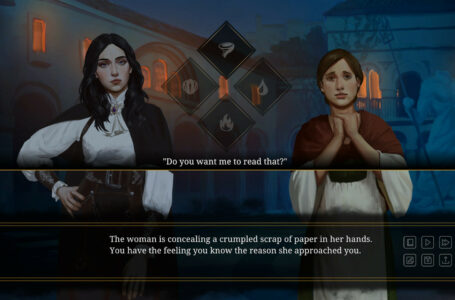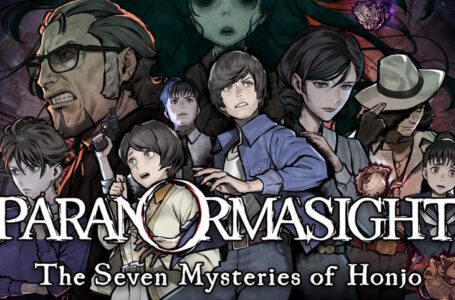The History of Lewd: Three Sisters’ Story
One of the things that has bugged me over the years about eroge is that, particularly in the early days of the west’s familiarity with them, they have often been incorrectly described as “dating sims”. And in the case of games like Sakura Soft’s 1996 title Three Sisters’ Story, the subject of today’s column, that’s a woefully inadequate descriptor.
Strictly speaking, the term “dating sim” should be reserved for games that are usually non-linear in nature, and which focus on establishing romantic and/or sexual relationships as their primary goal. In previous installments of this column we’ve seen both Casual Romance Club and True Love ’95; both of these are dating sims that approach the subject matter in slightly different ways.
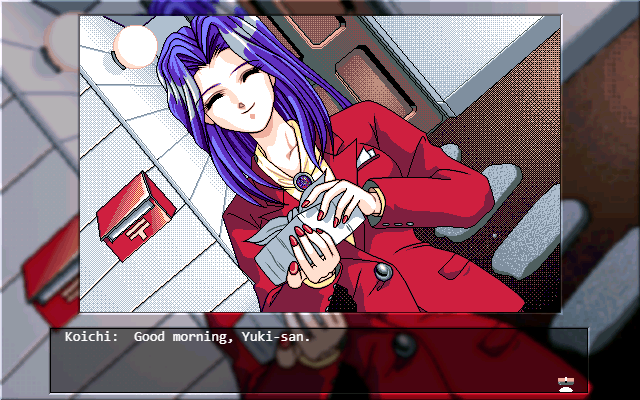
Three Sisters’ Story, meanwhile, is an interactive mystery adventure game that just happens to include some sexual content. It’s the very definition of an eroge (a game where narrative is the focus that just happens to include some sex) — and a direct contrast to a nukige (a game where the sexual content is the focus, and the narrative is of secondary importance).
You’ll notice I’m not describing Three Sisters’ Story as a visual novel. In some respects it is a visual novel — you follow through a mostly linear, almost entirely text-based story and make a few choices along the way, which ultimately determine which one of several endings you get — but its overall execution is different enough from today’s visual novels to make it worthy of distinction. But we’ll come back to all that in a moment.
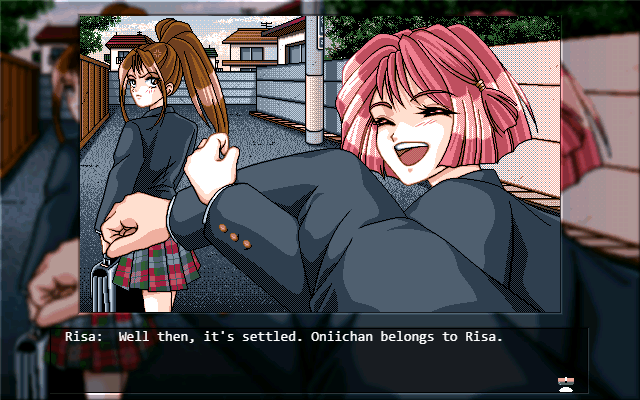
In Three Sisters’ Story, you take on the role of Koichi Sanada, a young man who has become embroiled in events beyond his control. After his father committed suicide as a result of some business deals gone wrong, Koichi and his brother Eiichi were separated, reuniting several years later after Eiichi had apparently managed to make something of his life.
Flush with cash, Eiichi hatched a plan with Koichi to exact revenge on Shoji Okamura, the man who had destroyed their father’s life and torn their family apart. Eiichi bought Koichi a house next door to the Okamura residence, and Koichi established a relationship with one of Okamura’s daughters who was around his age. From thereon, Koichi fed information back to Eiichi so he could plan out the perfect means of revenge — but one day Shoji Okamura fled, leaving the three Okamura sisters alone.
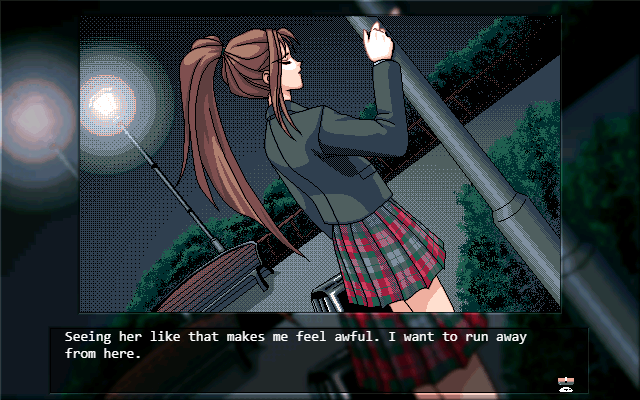
Koichi, having developed something of an attachment to all three sisters by this point, naturally starts to have second thoughts about the whole “revenge” thing, particularly once it becomes clear that Eiichi is becoming increasingly unhinged as time goes on — and that he has obviously done some fairly reprehensible things in order to get himself to his current situation. Thus, wracked with guilt for the lie he has lived alongside the Okamura sisters up until this point, Koichi decides to get to the bottom of what is going on, stop his brother and perhaps be able to put a smile back on the three sisters’ faces again.
I’ll level with you, dear reader: when I first stumbled across Three Sisters’ Story back around the turn of the century, I fired it up expecting some sort of incestuous yuri porn experience, given the title. My contact with eroge at the time had been fairly limited, after all; outside of Ring-Out!! and another game we’ll talk about in a subsequent installment of this column, most of my experience with erotic anime-style content had been through context-free images posted online.
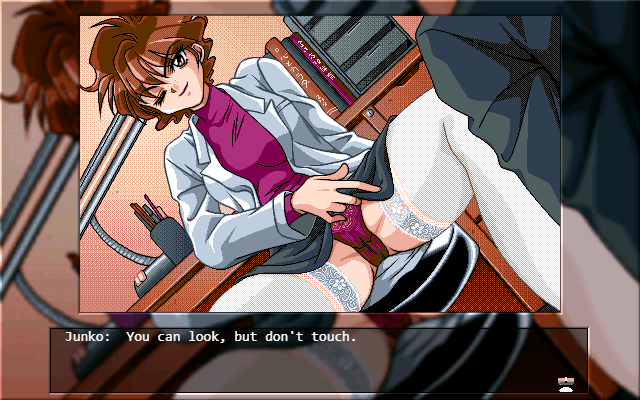
Several hours after starting Three Sisters’ Story up for the first time, I noticed it had got dark outside, I hadn’t had any dinner — and I was thoroughly engrossed in what this game had to offer. Shortly after, I beat the game for the first time — and I knew that I had experienced something that absolutely, definitely could not be described as “pornography” by any stretch of the imagination.
I had just played through a game that had made me think, made me feel and made me care deeply about its characters. And — more on this in a moment — I had also played a game in which, for the first time, long-term consequences of your actions were very much a real thing.
The reason why I hesitate to describe Three Sisters’ Story as a conventional visual novel is because the majority of your interaction with it is “active” rather than passive. During each main chapter of the story, you are presented with menus of options for what actions you are able to take, rather than simply clicking through pages of narration and dialogue before making an occasional choice.
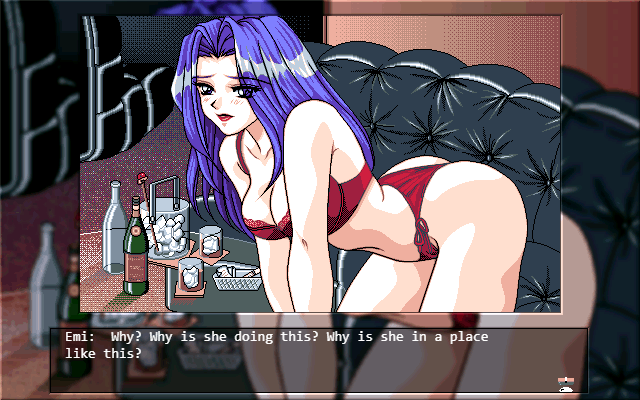
Like in Ring-Out!!, there’s generally only one sequence of actions you need to take in order to make the story progress, but the noteworthy thing about Three Sisters’ Story is that you’re given a surprising amount of freedom — something that was deliberately absent from Ring-Out!!, given the nature of its narrative. You can move between different locations, you can speak with incidental characters, and you can discover completely optional scenes along the way. There’s even a completely missable “sidequest” you can pursue if you so desire.
For example, on one of the first in-game days, Koichi is searching for Emi, the middle sister of the Okamura family and his girlfriend. She is seemingly nowhere to be seen around the school they both attend, which necessitates visiting pretty much every possible location and discovering a few surprises along the way. This also provides the opportunity for you to establish some initial relationships with some secondary characters, too, who become important if you decide to follow through on the aforementioned sidequest.
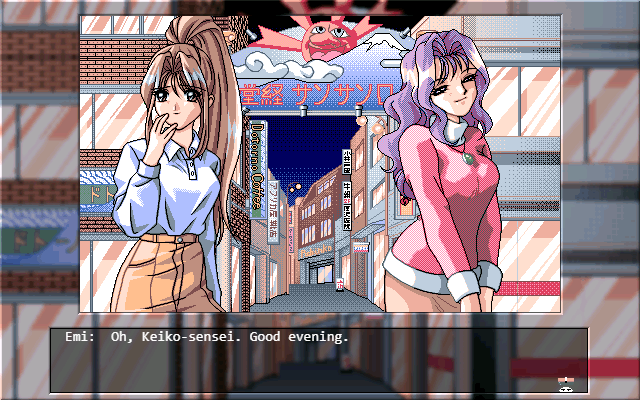
Later in the game, the stakes are raised considerably as Koichi pursues Eiichi and tries to uncover some mysteries about his brother — but again, the game keeps that sensation of “freedom” at its core at all times, even if there really is only one “correct” sequence of actions to proceed under most circumstances.
There’s an interesting exception to this: any time Koichi is presented with a difficult decision, you will often find yourself forced to make that choice several times in succession, with Koichi musing on whether he really wants to go through with whatever he’s considering each time.
This is the game really driving home the fact that you’re making an important and perhaps difficult decision; the fact that you have to click on a potentially upsetting option several times in succession is a surprisingly effective means of putting the player inside Koichi’s head as he struggles with the increasingly perilous circumstances in which he finds himself.
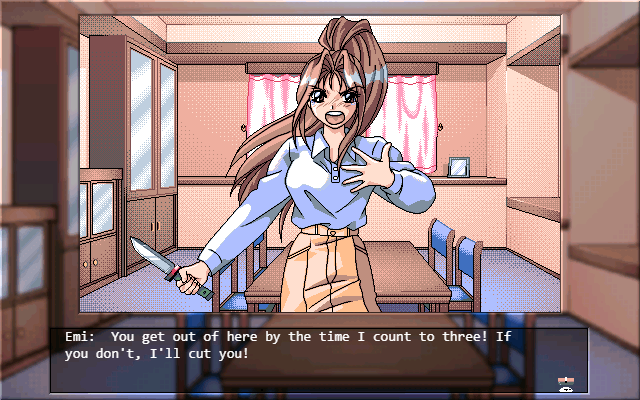
There are also a number of sequences throughout the game where you have the option to do something that is clearly, obviously, blatantly “wrong”. Koichi has a couple of opportunities to sexually assault someone, for example, with the simple option “RAPE” tucked neatly at the bottom of the list of available verbs as if nothing out of the ordinary was going on.
Under rather less potentially criminal circumstances, Koichi also has the opportunity to sleep with all three sisters over the course of the narrative, have sex with four girls he is “helping” overcome some personal problems (with or without a condom), bang several prostitutes — all in the name of investigation, you understand — and even become one of the many, many notches on the school nurse’s belt.
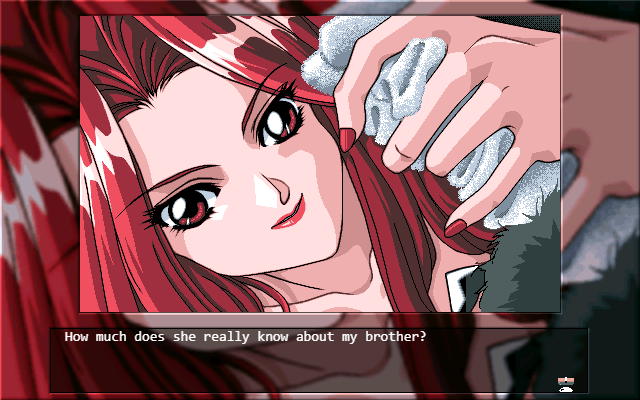
Interestingly, while Koichi can get away with some of these incidents — most notably the ones where a sexual encounter is a required part of uncovering some information — there are others that, as previously noted, have long-term considerations. Having sex without a condom, for example, means that you run the risk of impregnating at least one of the girls, which naturally puts something of a dampener on Koichi’s relationship with Emi. Likewise, should the three sisters discover that you’ve actually been boning all of them, none of them will take you seriously in the end.
To be fair, the game gives you ample warning of what the “correct” choice of action under most circumstances is — the early, establishing moments of the narrative take great pains to point out that Koichi only has genuine romantic and sexual feelings for Emi out of the three sisters, for example, plus most people are hopefully self-aware enough to know that picking “RAPE” from a menu is usually a bad idea — but it’s interesting that it follows through on these decisions in the long term rather than providing an immediate bad ending.
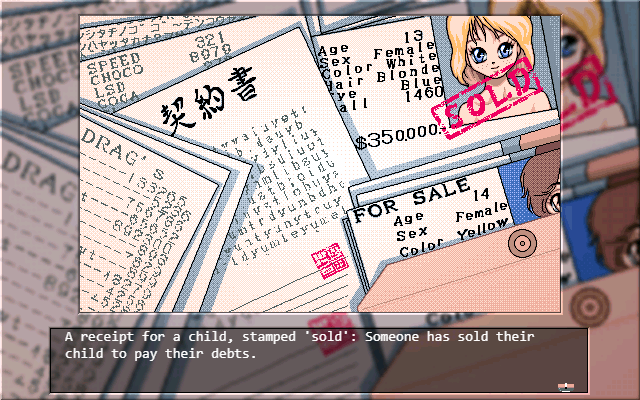
In fact, it’s possible to get all the way through the game and resolve the main conflict at the heart of the story, then still end up with a “bad” ending. On the one hand, this can feel like a punch in the gut after all your hard work; on the other, you deserve everything you get. And it’s this side of things in particular that really impressed me back when I first played Three Sisters’ Story — and still impresses me now.
Three Sisters’ Story is a genuine, honest-to-goodness example of a piece of proper entertainment intended specifically for adults — and, unlike Ring-Out!!, it never feels like it’s being edgy or explicit for the sake of shock value. The sexual content is part of the whole experience, but far from the main attraction — indeed, significant portions of the game unfold without any vaguely provocative, let alone explicit, content whatsoever — but the game doesn’t hold back from showing the seedier side of life when required.
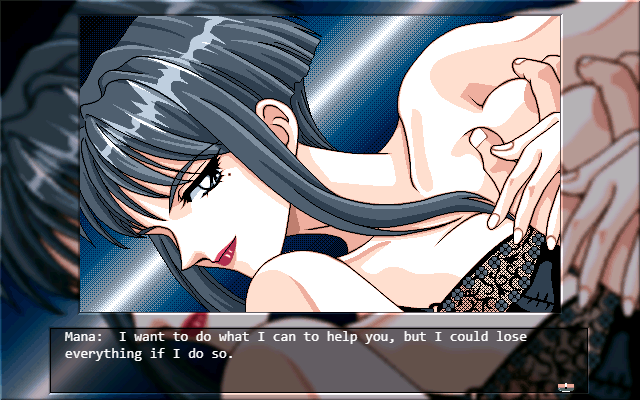
In many ways, it feels like a spiritual precursor to more modern titles like Frontwing’s excellent Grisaia series; that, like Three Sisters’ Story, features a similar setup of a main narrative that has nothing to do with establishing and maintaining romantic and sexual relationships, but instead incorporates erotic and romantic content into its narrative in a natural and convincing manner.
It’s also a reminder of a very distinct era in Japanese popular entertainment; people think back fondly on ’90s anime for very good reason, and titles like Three Sisters’ Story demonstrate that interactive entertainment followed a lot of the same trends of the time. It was around this era that the rest of the world was starting to realise and recognise that animation and anime-style artwork wasn’t just for kids — and titles like this were great examples of “doing it right”.
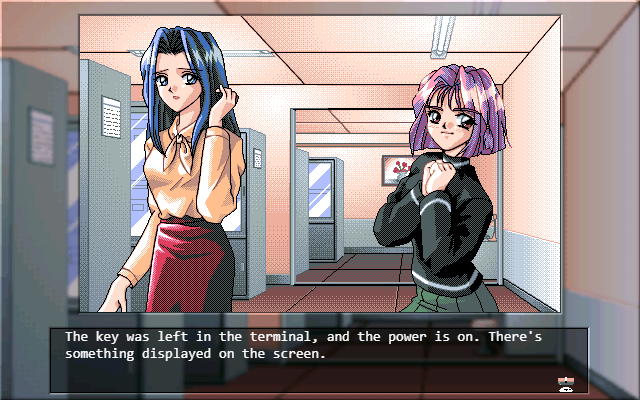
Unfortunately, Three Sisters’ Story is difficult to get up and running on modern computers in its original form; its original release was MS-DOS based, but JAST 2002’s Windows conversion doesn’t play nice with modern machines, either. Thankfully, the wonderful people at the Asenheim Project have got the game running on their site — you can even switch the visuals between the lovely sharp-edged pixel art of the MS-DOS original or the softer, filtered look of the Windows release.
Alternatively, you can also play the game as part of JAST USA’s JAST Classic Game Archive site, proudly powered by the Asenheim Project folks. (Note that they’ve been using an image from Ring-Out!! to promote Three Sisters’ Story ever since they launched this page; I’ve told them several times but they haven’t changed it yet!)
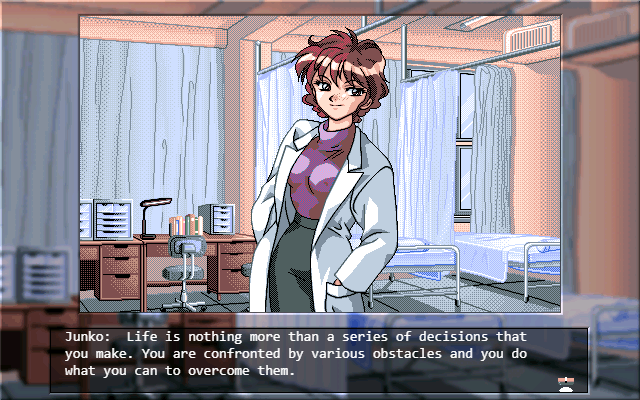
However you choose to access it, Three Sisters’ Story is a wonderful piece of interactive entertainment that is still genuinely well worth your time today. It’s one of the most potent examples of visual novels being more than just “dating sims” out there — not to mention also one of the best examples of eroge being more than just porn.
Now get in there and save the Okamura family; Emi needs you!
Join The Discussion
Rice Digital Discord
Rice Digital Twitter
Rice Digital Facebook
Or write us a letter for the Rice Digital Friday Letters Page by clicking here!
Disclosure: Some links in this article may be affiliate links, which means we may earn a small commission if you make a purchase after clicking on them. This is at no additional cost to you and helps support Rice Digital!
- Letter from the Editor: passing the torch - June 30, 2023
- Super Woden GP 2 is looking promising - June 30, 2023
- Inti Creates is making a 32 bit-style Love Live action platformer - June 26, 2023






